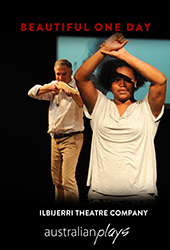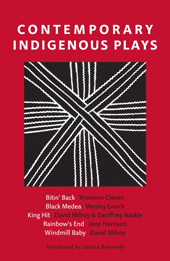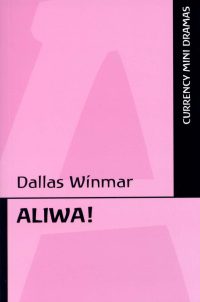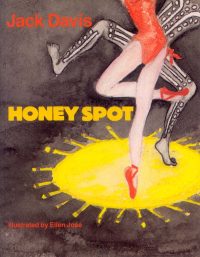
ADVICE
Aboriginal and Torres Strait Islander visitors are advised that this website
may contain images and voices of deceased people.
About the Collection
The BlakStage collection is an international gateway to the best of Australian First Nations playwriting.
The collection is developed under the artistic guidance of leading First Nations writers and theatre-makers. Playscripts – groundbreaking early works alongside noteworthy newcomers – are augmented with interviews, videos, photos and production histories as well as cultural protocols and teaching guides.
It is a remarkable and rapidly evolving body of work, grounded in ancient storytelling traditions.
Blakstage was launched in 2013 and continues to grow. It was initially assisted by the Sidney Myer Fund and by the Australian Government through the Australia Council for the Arts, its arts funding and advisory body. We thank the following organisations and individuals who contributed time and expertise to bring BlakStage to fruition: Cathy Craigie, Liza-Mare Syron, Ray Kelly, Diat Alferink, Maryrose Casey, Wesley Enoch, Yirra Yaakin Aboriginal Theatre Company, Ilbijerri Theatre Company, Magabala Books, Black Words, Kurruru Youth Performing Arts, Kyle Morrison and Jane Harrison.
SCRIPT SUBMISSIONS
All titles listed on Australian Plays, including those featured in BlakStage, are either published by one of our partners,
such as Currency or Playlab, or have been accepted into the Australian Script Centre’s catalogue.
We welcome the submission of unsolicited scripts to BlakStage. Information on the eligibility, submission
and assessment of scripts can be found here.
Resources
TEACHING FIRST NATIONS CULTURE AND CONCEPTS IN THE DRAMA CLASS ROOM
ADVICE FOR TEACHERS IN VICTORIAN SCHOOLS
This resource was developed by Kamarra Bell-Wykes (on behalf of ILBIJERRI Theatre Company), Rachel Forgasz (Monash University), Danielle Hradsky (Monash University), in partnership with Drama Victoria.
ATSI GUIDELINES FOR DRAMA/THEATRE EDUCATION
DRAMA AUSTRALIA
The preparation of this document was commissioned by Drama Australia to foster access and participation in learning, taking in the broader context of Indigenous educational perspectives and redefining their relevance in the study of Contemporary Indigenous.
PROTOCOLS FOR USING FIRST NATIONS CULTURAL & IP IN THE ARTS
AUSTRALIA COUNCIL FOR THE ARTS
PROTOCOLS FOR USING FIRST NATIONS CULTURAL AND INTELLECTUAL PROPERTY IN THE ARTS
PUBLISHED OCTOBER 2020
BRIEF HISTORY OF INDIGENOUS AUSTRALIAN THEATRE
BY MARYROSE CASEY AND CATHY CRAIGIE
Indigenous theatre specialist, Dr Maryrose Casey and Cathy Craigie, a Gamilaroi and Anaiwan woman with wide ranging experience in theatre, writing and arts leadership, have collaborated to produce this informative overview of the historical context, pivotal works and important milestones in contemporary Indigenous theatre. This essay, commissioned by BlakStage, is an excellent starting point for the study of Indigenous theatre.
AN ACTOR PREPARES: WHAT BRIAN TOLD ME
BY LIZA-MARE SYRON
Descendent of the Birripi people and well-known theatre maker and educator, Liza-Mare Syron recounts her journey of discovery into her Aboriginal heritage, in the footsteps of her extraordinary uncle, human rights advocate, teacher, actor, writer and director, Brian Syron.
PERFORMANCE NOTES FOR EDUCATORS
QTC / EDUCATION QUEENSLAND
Produced by Queensland Theatre Company and Education Queensland for the QTC education performance of The 7 Stages of Grieving.
BRINGING THEM HOME
AUSTRALIAN HUMAN RIGHTS COMMISSION
In 1997, the Human Rights and Equal Opportunity Commission (now the Australian Human Rights Commission) released its report, ‘Bringing them home: National Inquiry into the Separation of Aboriginal and Torres Strait Islander Children from Their Families’. To assist students’ understanding of the issues surrounding this report, a range of resources and support materials are made available for download. This includes a lesson plan for Jane Harrison’s play, ‘Stolen’.
FROM THE FLOATING WORLD TO THE 7 STAGES OF GRIEVING
KEIJI SAWADA, MACQUARIE UNIVERSITY, 2005
ACADEMIC PAPER: “Many Australian plays have been presented in Japan since the middle of the 1990s. This thesis demonstrates that in presenting Australian plays the Japanese Theatre has not only attempted to represent an aspect of Australian culture, but has also necessarily revealed aspects of Japanese culture.” (K. Sawada)
SHOW ME THE CULTURE!
REALTIME ARTS MAGAZINE, ISSUE 111, 2012
“Many well-established Indigenous theatre practitioners insist that culture is at the heart of their practice. Where then are the opportunities for such an engagement with culture as part of vocational training? Also, insofar as such opportunities do exist, how can we account for the differences between the various professional training programs available to Indigenous actors?”
DIRECTOR WESLEY ENOCH MAKES STAGE HISTORY
ROSEMARY SORENSEN, THE AUSTRALIAN, JUNE 2010
“BORN in the same year as the Queensland Theatre Company, Wesley Enoch says he was determined as far back as his teenage years to become its artistic director by the time he turned 40.”
JUSTINE SAUNDERS: A FIGHT AGAINST THE STEREOTYPE
GERRY CARMAN, SMH.COM.AU, APRIL 2007
“JUSTINE SAUNDERS, the prominent Aboriginal actor of stage, film and television, played a key role in creating frameworks for other indigenous actors to develop their craft, and took a strong national stance on the issue of the stolen generation.”
BLACK WORDS WHITE PAGE: ABORIGINAL LITERATURE 1929–1988
ADAM SHOEMAKER, ANU, 2004
ACADEMIC PAPER: “Fifteen years after its first publication, Black Words White Page remains as fresh as ever. This award-winning study – the first comprehensive treatment of the nature and significance of Indigenous Australian literature – was based upon the author’s doctoral research at The Australian National University and was first published by UQP in 1989.”
CREATING FRAMES
MARYROSE CASEY, UNIVERSITY OF QUEENSLAND PRESS, 2004
This book is the first social and cultural history of the theatre created by Indigenous Australian artists. Based on interviews with practitioners including Bob Maza, Jack Charles, Gary Foley, Justine Saunders, Wesley Enoch and John Harding and archival research, the book tells the story of Indigenous Australians producing theatre in the twentieth century. This link provides access to a Google Books preview of the text, with links to distributors of the publication.
INDIG-CURIOUS
JANE HARRISON, QUEENSLAND UNIVERSITY OF TECHNOLOGY, 2009
ACADEMIC PAPER: “What are the challenges for non Aboriginal theatre practitioners in accessing and interpreting Aboriginal themes? How do non-Indigenous theatre practitioners, especially actors, access and incorporate Aboriginal themes in the plays they create or perform in? Will it ever be acceptable for a non-Aboriginal actor to play an Aboriginal role?”
PERFORMING AUSTRALIA’S BLACK AND WHITE HISTORY
ALISON LYSSA, MACQUARIE UNIVERSITY, 2006
ACADEMIC PAPER: This thesis compares testimony to Australia’s black/white relations in two plays by white writers, Andrew Bovell’s ‘Holy Day’ (2001) and Katherne Thomson’s ‘Wonderlands’ (2003), and two black writers, Tammy Anderson’s ‘I Don’t Wanna Play House’ (2001) and Richard J. Frankland’s ‘Conversations With the Dead’ (2002)
RECENT INDIGENOUS THEATRE IN AUSTRALIA
HILARY GLOW, DEAKIN UNIVERSITY, 2006
ACADEMIC PAPER: “Over the past decade Australian theatre has seen an increased profile for works written and created by Indigenous artists. This paper looks at the development of Indigenous theatre in Australia and considers how increased mainstream production opportunities have facilitated this expansion of Indigenous theatre practice.”
THE NATIONAL BLACK THEATRE
ZOE POLLOCK, DICTIONARYOFSYDNEY.ORG, 2008
“The National Black Theatre was a theatre company run by a small group of Aboriginal people based in the Sydney suburb of Redfern. The original concept for the theatre grew out of political struggles, especially the land rights demonstrations which at the time were being organised by the Black Moratorium Committee….”





